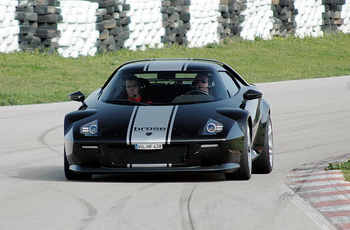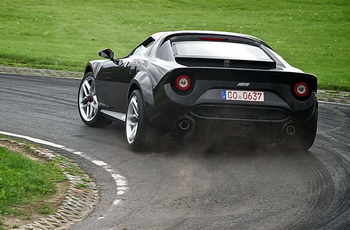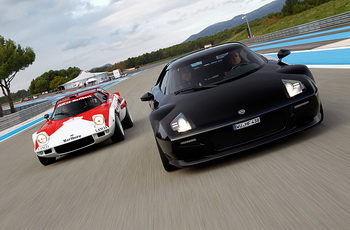

 |
|
One of the most exciting automotive projects
of recent years, the stunning remake of
Lancia’s legendary Stratos supercar, has
been quietly shelved as Ferrari appears to
have put a firm block on any chance of
production. |
|
|
|
 |
|
Ferrari President Luca di Montezemolo (in
cockpit with Michael Stoschek) actually
tried the New Stratos for himself at the
Fiorano test track in November 2010. |
|
|
|
One of
the most exciting automotive projects of recent years,
the stunning remake of Lancia’s legendary Stratos
supercar, has been quietly shelved as Ferrari appears to
have put a firm block on any chance of production.
The project, the bold dream of German auto components
magnate and rally enthusiast Michael Stoschek, was as
dramatic in the flesh as the original images suggested –
so dramatic, in fact, it appears to have fallen foul of
Ferrari’s CEO. Using Ferrari’s 430 Scuderia as a donor
car, the shortened, lightened chassis was thoroughly
reworked in every area to form the base for the New
Stratos, and the same applied to the car’s 4.3-litre V8
engine. The project touted a power-to-weight ratio of
less than 2.3 kg/hp, with a 0-100 km/h acceleration time
of 3.3 seconds and 0-200 km/h clocked in just 9.7
seconds.
Earlier on, it appeared the New Stratos had received the
implicit blessing of Ferrari, with President Luca
Montezemolo personally experiencing the New Stratos at
the company’s Fiorano test track. With the project
having been handled from its inception by Pininfarina,
the long-time hand behind Maranello’s sports car
lineage, it seemed progress was building towards a
limited production run – around 50 individuals were said
to have expressed interest in purchasing an example,
despite a price tag in the region of half-a-million
euros.
Unfortunately, the degree of performance extracted from
the purpose-built car, combined with handling
meticulously honed with the expertise of former F1
driver Tiago Monteiro, appears to have shaken Ferrari’s
top management, with a statement posted on the project’s
website citing interference from Ferrari as the reason
why a production run could not be arranged.
“This decision stems from
Ferrari CEO Dr. Amedeo Felisa’s opposition to the
production of any further vehicles by companies that
work with Ferrari,” it states. “As readers of this are
no doubt aware, the body of the New Stratos is built on
a shortened Ferrari 360 or 430 chassis – meaning it
presents absolutely no competition to the current 458.”
It should be noted, however, that Stoschek’s creation
had been touted as a car that had outperformed peers
such as the aforementioned 458 Italia, Lamborghini’s
Gallardo Superleggera and Porsche 911 GT3 RS in
back-to-back tests.
With Pininfarina still struggling to achieve financial
viability, there is, on the face of it, little reason
for them to have turned down any high-value engineering
opportunities, so the likelihood is that the company
received external pressure. On top of the urgent need
for revenue, Pininfarina has been shorn of all its
traditional contract manufacturing operations; this
division had entered into a string of ill-judged
ventures in the middle of the last decade that racked up
a debt mountain and brought the famous Turinese design
and engineering concern to its financial knees. Building
the New Stratos would have demonstrated that Pininfarina
still retained the ability to carry out potential
game-changing niche projects, and with the car
attracting a huge amount of international attention, it
could have turned into a halo project that brought the
company much global prestige.
With strong interest in a New Stratos production run,
and the Pininfarina route now reportedly blocked,
Stoschek tried to find a company outside Italy – one
well away from the reaches of Ferrari’s perceived
influence – to build the supercar in a limited run,
still using the 360/430 as a donor vehicle.
However, in a statement on his website, Stoschek says he
was unable to unpick the project from Pininfarina, such
was the coachbuilder’s integral involvement, having
developed the New Stratos project from the ground up.
“Throughout the past year, we conducted negotiations
with several different low-volume manufacturers outside
Italy,” continues the statement. “We were forced to
conclude that it’s virtually impossible to transfer to
other companies the know-how garnered at Pininfarina
during the construction of our model. While the chassis
and body data exist in CAD files in their entirety,
there are countless details relating to the assembly and
finishing that remain solely in the minds of a number of
highly-qualified individuals at Pininfarina.”
The car’s cause was not helped by the failure of Lancia
management to grasp the marketing opportunity sitting
before them. Despite enthusiasm from the project’s
backers for official Lancia involvement, former brand
CEO Olivier François revealed in an interview last May
that there was no interest in using the New Stratos to
increase the brand’s visibility. He argued the car was
too far removed from the brand’s current lineup and
raised expectations the brand could not fulfil. However,
this argument sidesteps the fact the original Stratos
likewise bore effectively no relation to Lancia’s
regular production cars of the 1970s. It was effectively
a homologation special, an indulgence Lancia was allowed
only on the understanding it swept the board in
international rallying – a task it succeeded at
spectacularly. Yet despite the small number of roadgoing
versions built, they acted as a high-profile beacon for
the brand, and are still extremely well-remembered today
as one of Lancia’s most famous models.
While Stoschek has been a real stickler for adherence to
history with this reinterpretation of the original –
even down to details such as recreating the original
icon’s helmet pockets – the story does have a neat,
albeit sad, parallel with history. When Lancia, after
equipping the prototype Stratos with a variety of
alternative powerplants, decided that Ferrari’s powerful
Dino V6 was the best possible choice if it was to become
a rally winner, its desires fell on deaf ears at
Maranello. On that occasion, it took persuasion from the
highest levels of Fiat management, up to and including
Gianni Agnelli, to secure a supply of engines, and not
before Lancia had threatened to equip the Stratos with
the 4.7-litre V8 from the Maserati Bora. Without any
official backing or interest from Lancia towards the new
project, it was perhaps inevitable that Stoschek was
always going to find it difficult for Maranello to
acquiesce to the arrival on the scene of a potential
home-grown Ferrari-beater.
ItaliaspeedTV:
Michael Stoschek and
Dieter Hawranke (New Stratos) Sachsenrallye 2011
|
|
|